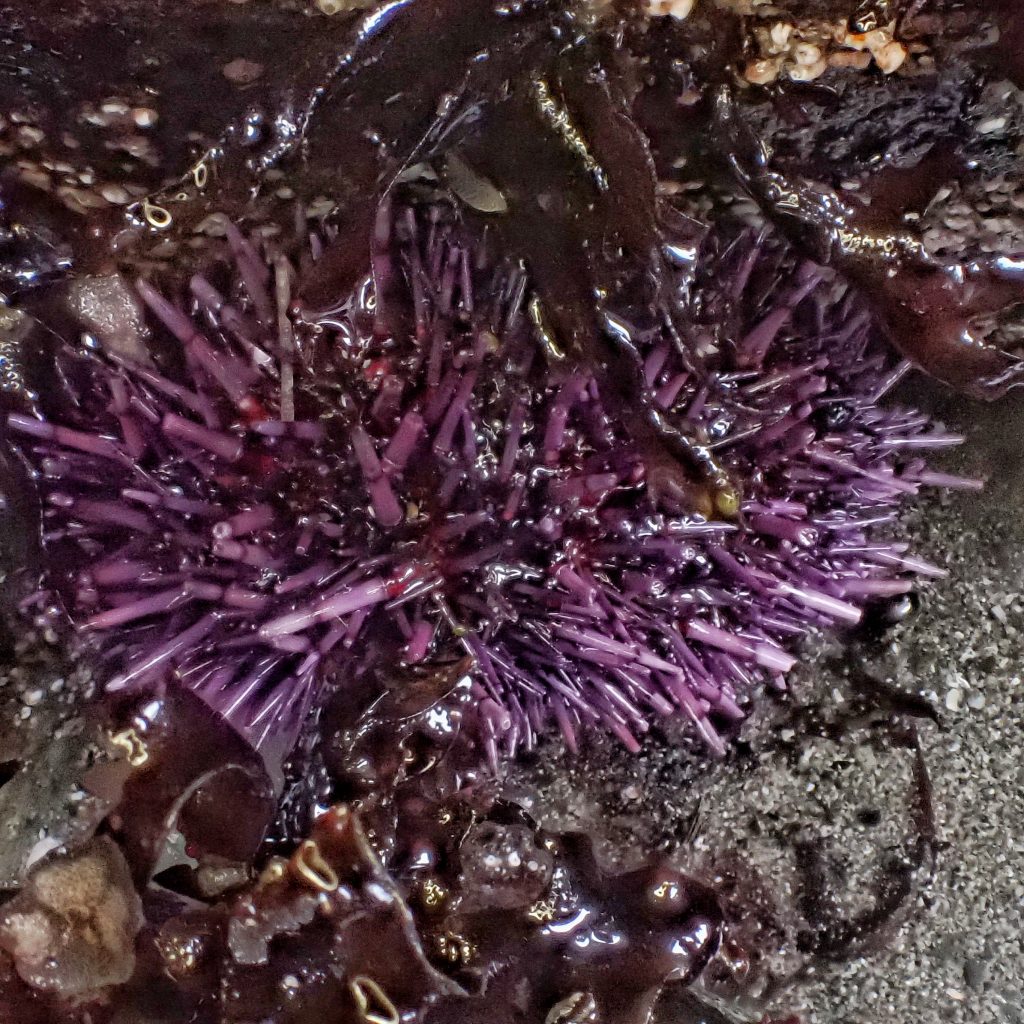
I am embarrassed to admit that I knew almost nothing about the biology and ecology of purple sea urchins (or for that matter sea urchins in general) before I started researching this profile. I wasn’t even aware that the beautiful, globular shells that I sometimes found, with geometric arrangements of colors, holes, and different sized bumps, were actually the shell (technically called a test) of a sea urchin. My first clue to that came when I saw one that still had purple spines clinging to it. So I’m going to start by talking about the structure and anatomy of sea urchins in general. But first you may want to watch this video by Hakai Wild, which shows most of the structures I’ll be writing about, although the bulk of the animals shown are green sea urchins (Strongylocentrotus droebachiensis) and giant red sea urchins (Mesocentrotus franciscanus).
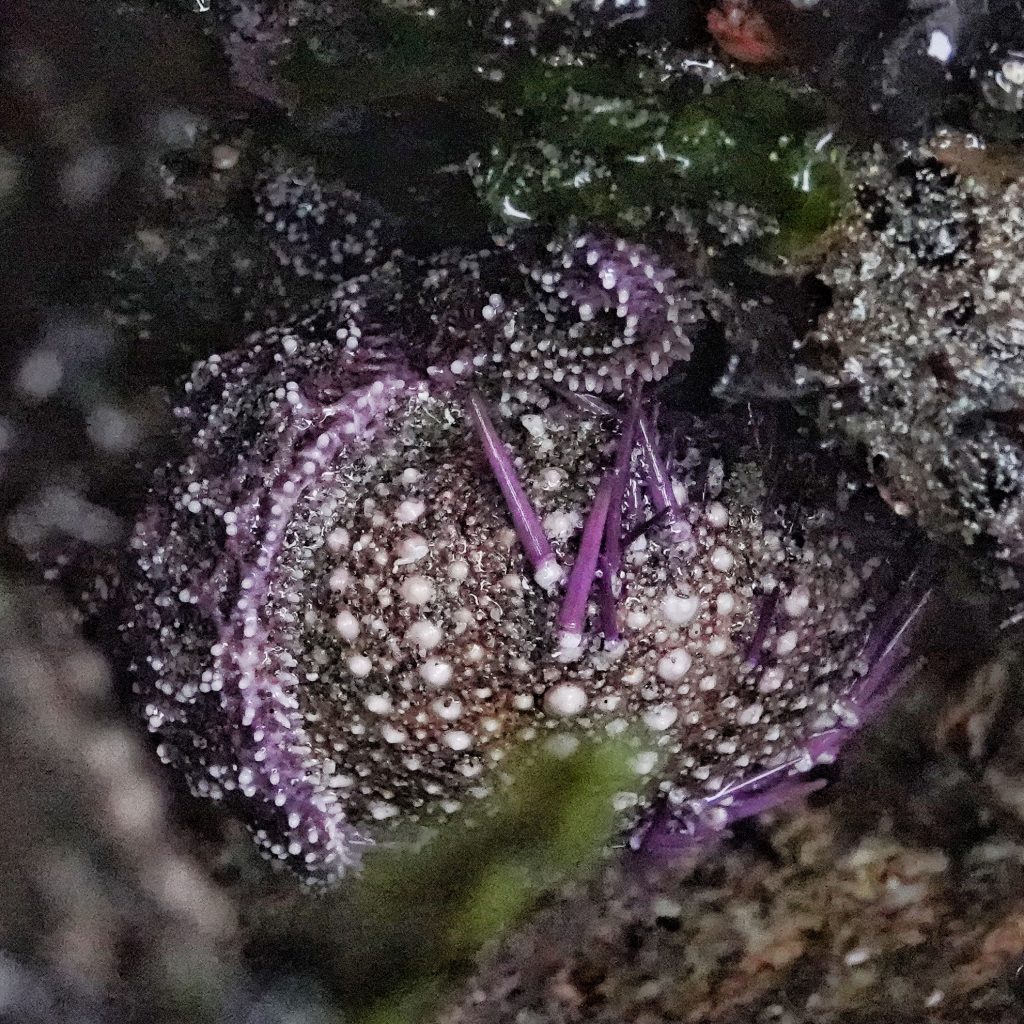
As mentioned above, sea urchins have a calcareous test, which protects their internal organs, and upon which the spines (which are also calcareous), tube feet, and pedicellariae grow. In the center at the top is an opening which houses the anus, gonadal pores (called gonopores), and the madreporite. The madreporite is the intake valve for the water vascular system (which, among other things, powers the tube feet) of sea urchins and other Echinoderms, such as sea stars, sea cucumbers, sand dollars, and crinoids. The mouth, which is often called Aristotle’s lantern (shown in a nice video from the Birch Aquarium) because of Aristotle’s remarking on its resemblance to the five sided horn lanterns of his day, is located in the center of the bottom of the test, which is the reason that, as they also do with many other echinoderms, biologists refer to the bottom as the oral side, and the top as the aboral side.
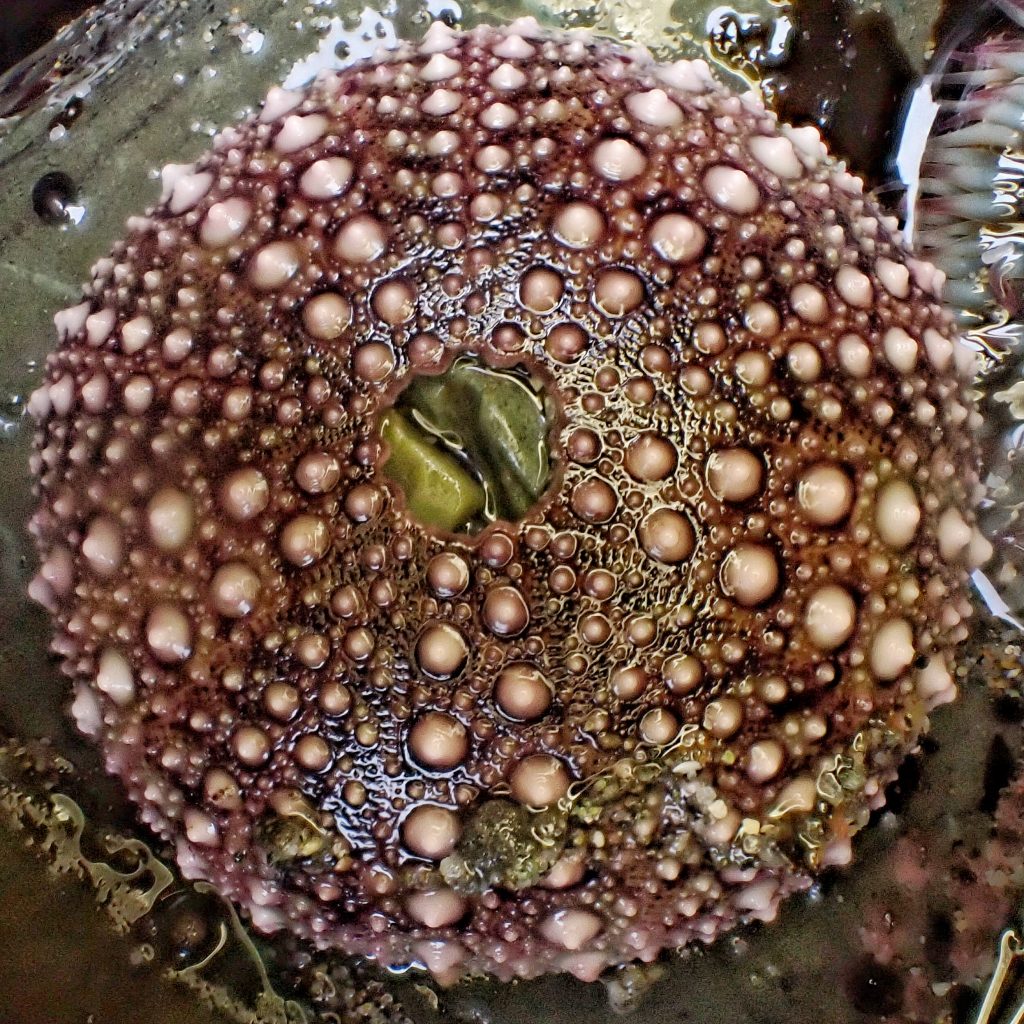
The multipurpose spines are located on both the oral and aboral parts of the test (anchored by a ball and socket mechanism to the tubercles visible as bumps in the postmortem test), and are moveable. They carry food to the mouth, aid in locomotion and defense, and have tiny cilia that create current around the body. The tube feet are also located on both the oral and aboral surfaces of the test, and coalesce to form a single tube foot after passing through tiny, paired holes in the test. Those on the oral surface are involved in locomotion (video from the Oregon Kelp Alliance of a walking purple sea urchin here), and all of them help carry food to the mouth and are responsible for oxygen intake. The pedicellariae are part of the skin of the urchin, and aid in predator defense (when sensing the approach of a sea star, purple sea urchins will sometimes expose the pedicellariae by spreading the spines, and then clamp onto the sea star when it attempts to attach, which usually causes it to withdraw), and help dislodge the barnacles, sponges, and other animals that attempt to attach to the urchin as a substrate. Contrary to popular belief (and much of what is written by people who should know better), it is not the spines but the pedicellariae that do contain small amounts of venom (O’Connell/Allender/Wood; 1974)
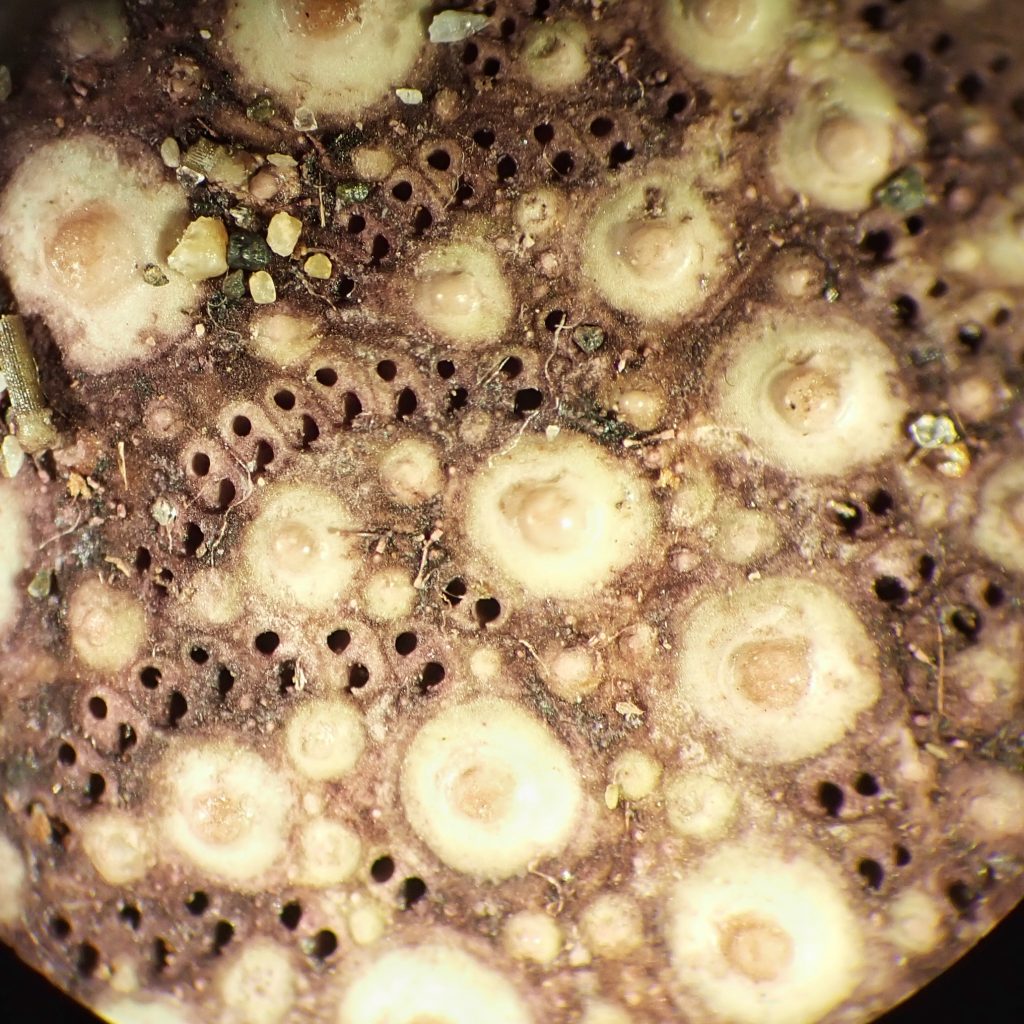
Sea urchins often attach to a substrate of rock, and if it is a soft sedimentary rock they may bore holes into it using their teeth and spines, both of which will regenerate (teeth are usually replaced in about 75 days). They can become completely immersed in the rock, which gives protection from predators, but limits them to food which drifts by. The burrows can also become a prison, if the urchin grows larger than the hole they originally bored into the rock. They will also frequently attach their tube feet to shells, rocks, and other debris, and use them as a shield over their body, as protection against UV rays, moisture loss, and predators.
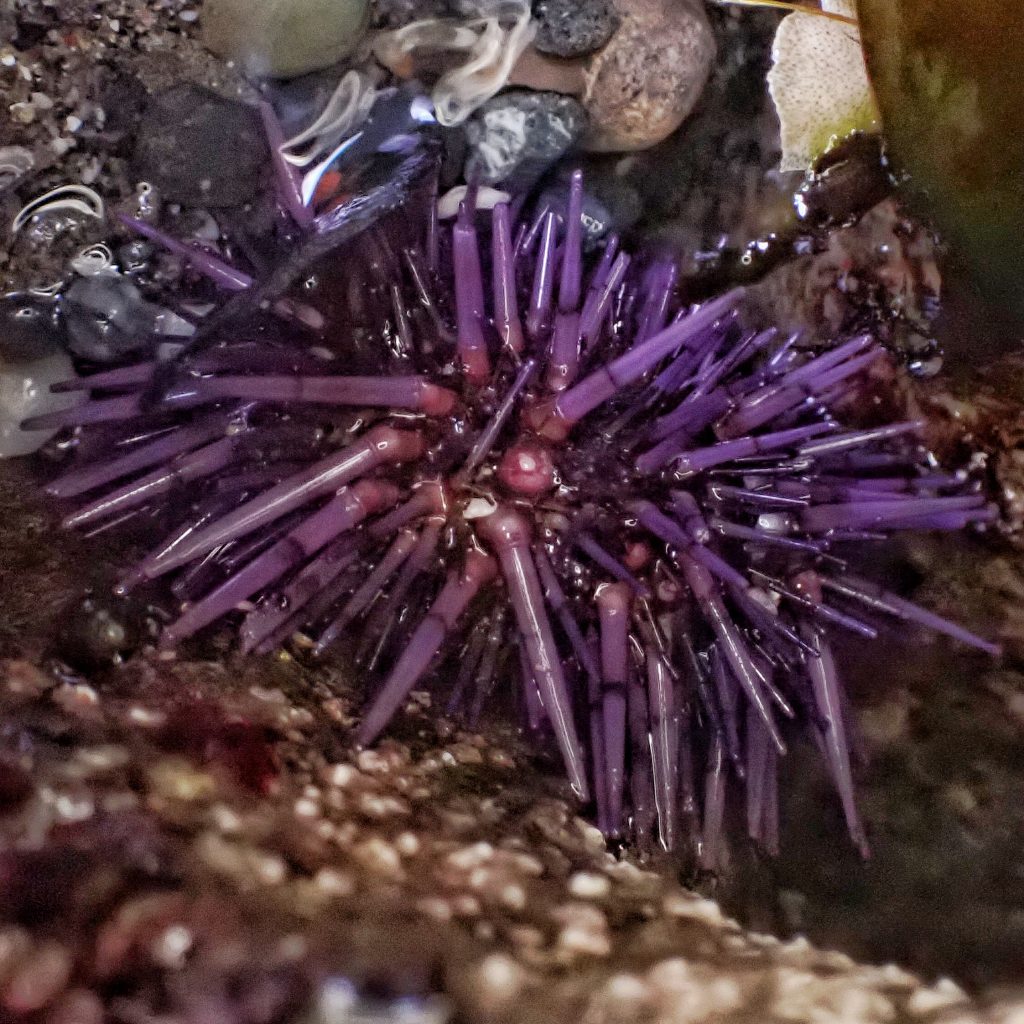
Sea urchins are eyeless, but they do have low resolution light sensing areas (called opsins) on their pedicellariae, and on the tips of their tube feet. Nor do they have a brain, relying instead on neural nets and a nerve ring near the mouth to coordinate their inputs and responses. They also don’t have any organ like a nose, but instead have tiny chemoreceptors on many of the spines, tube feet, and pedicellariae. These enable them to ‘smell’ an approaching predator and to move away.
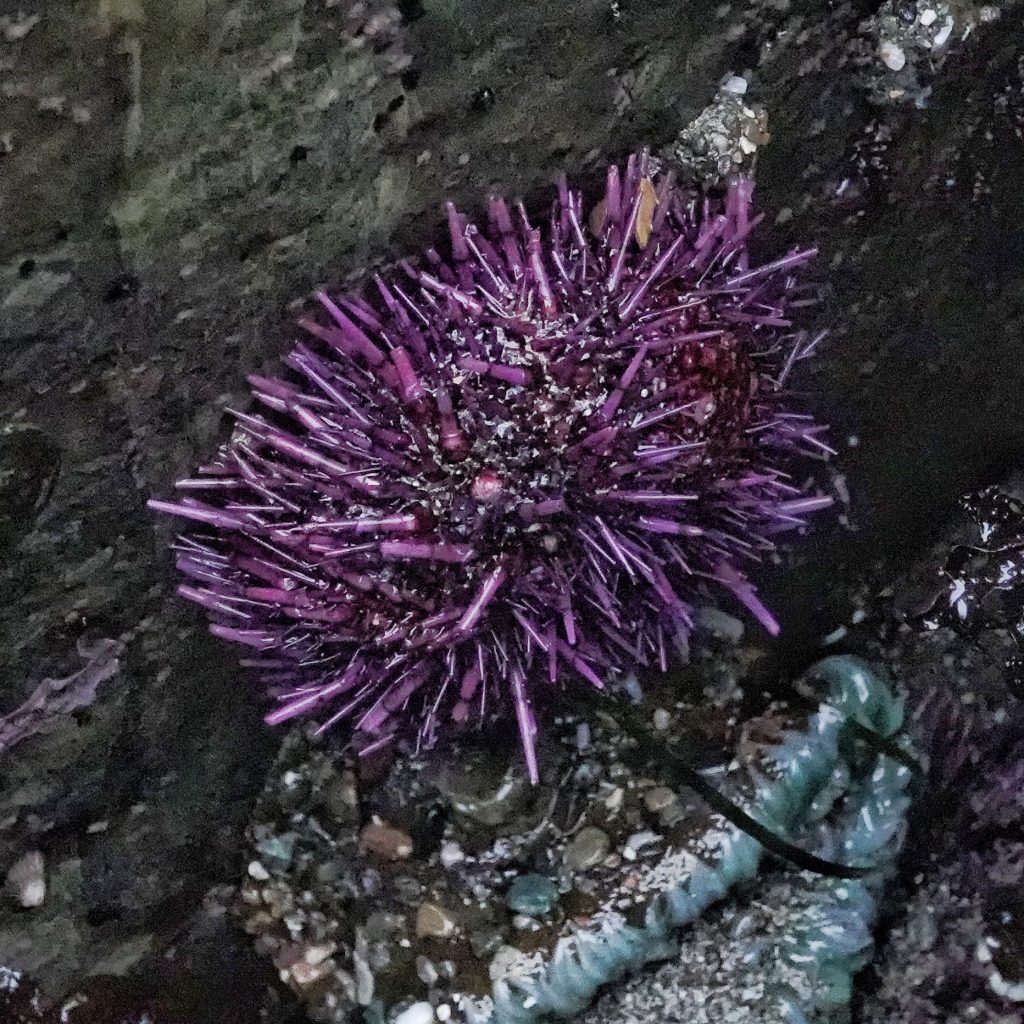
Purple sea urchins (and urchins in general) have a quite sophisticated immune system that features the adaptive immunity found in many mammals, which can manufacture a response to pathogens not previously known, and ‘remember’ that response the next time that that pathogen is detected. But they also have innate immunity, the kind that is most commonly found in invertebrates, where the system only has a limited number of responses to being attacked. Because of this disease resistance purple sea urchins have been known to live over 70 years, although predation usually takes them out by the time they are 20.
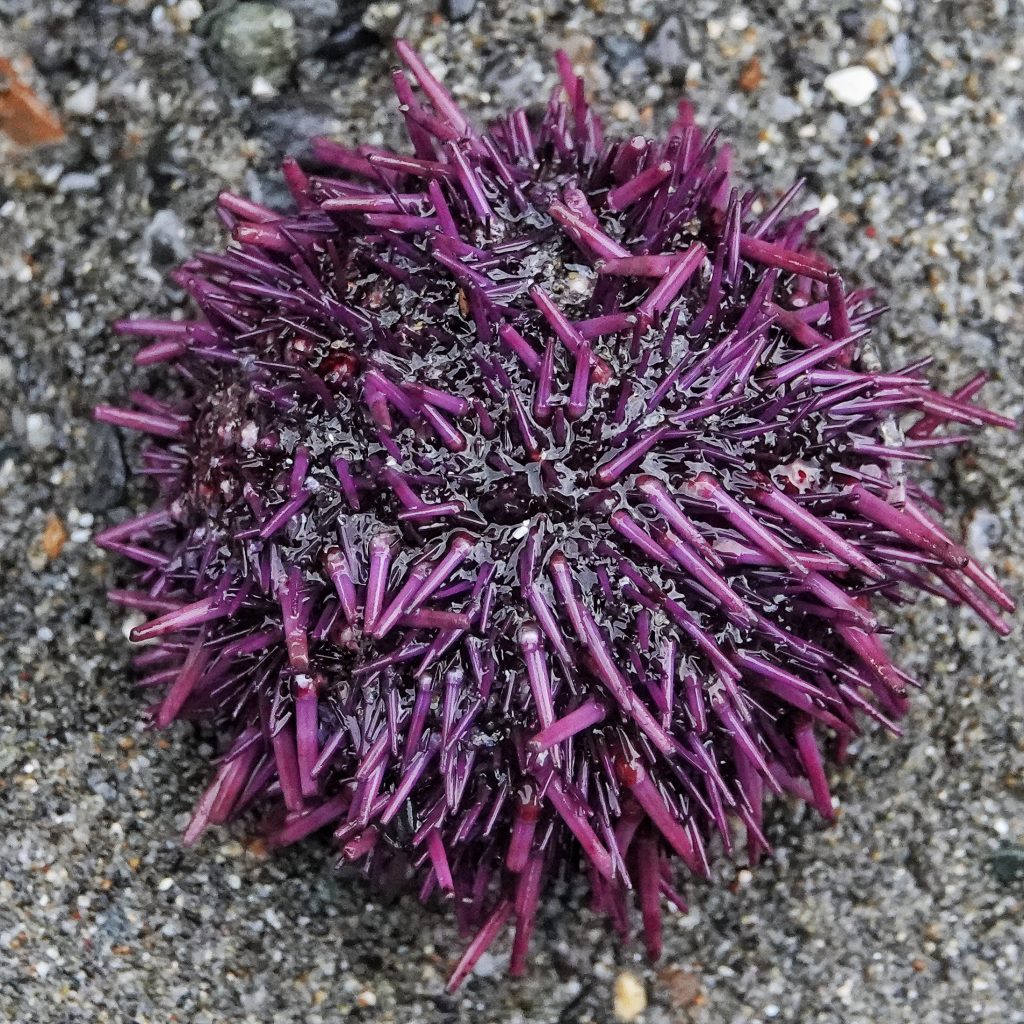
Purple sea stars can tolerate up to 20% dilution of seawater (so they are not deterred by small freshwater streams and runoff from precipitation), and water temperatures up to 74⁰, but anything over 78⁰ results in death (Cowles; 2005). They require well oxygenated water, which is why they are usually found in areas with significant wave action. They feed on brown algae (kelp) and red algae, and prefer Macrocystis pyrifera (giant kelp) and Nereocystis luetkeana (bull kelp) when they are available.
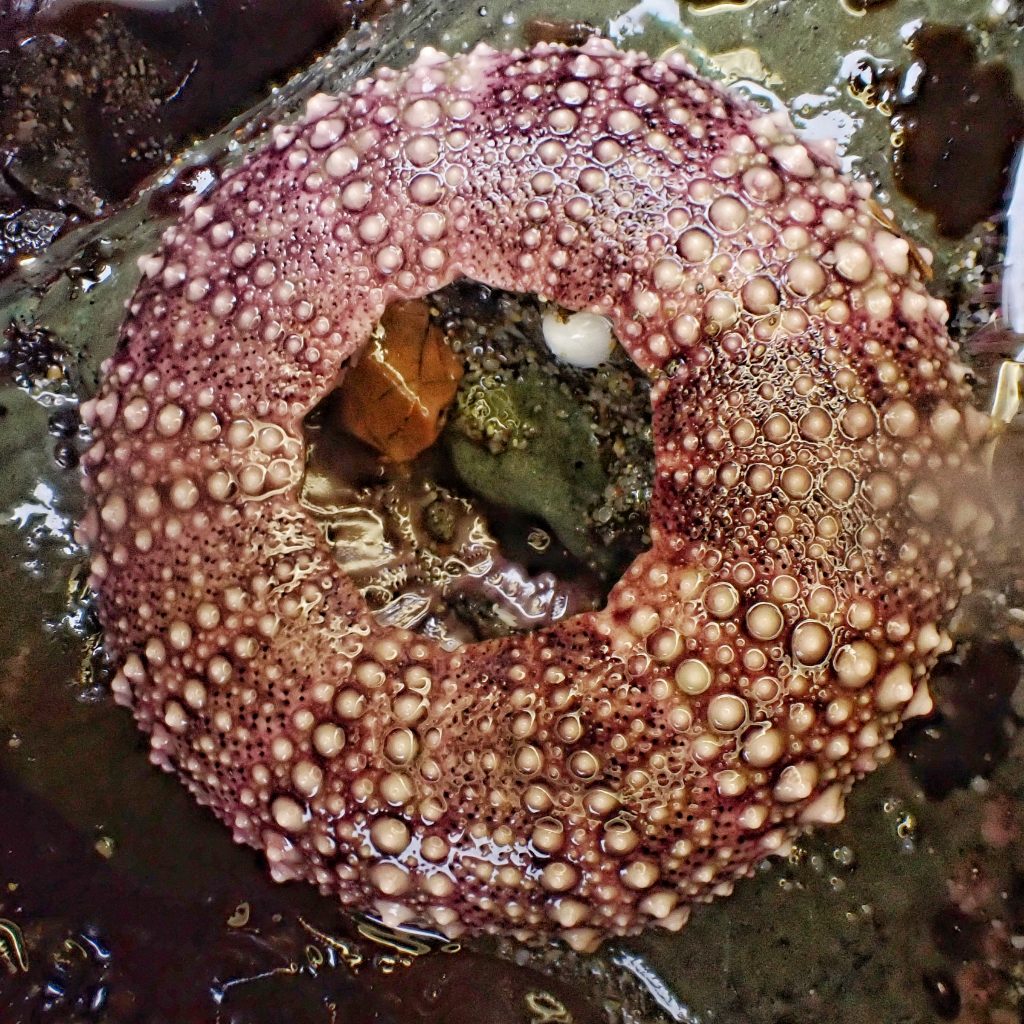
In conjunction with the near extirpation of sea otters, which historically have been one of their primary predators, the recent massive die-off of Pycnopodia helianthoides (sunflower sea stars, their other primary predators) due to Sea Star Wasting Syndrome (SSWS, which I wrote about in the profile of Pisaster ochraceus), has allowed the population of Strongylocentrotus purpuratus to explode. This has had a major impact on some kelp forests (since the purple sea urchins often eat through the stem and thus kill the whole organism) along the Pacific coast, which were already stressed by above average ocean temperatures and the concomitant loss of cold, nutrient rich upwellings from the sea floor, and has resulted in urchin barrens, with massive numbers of purple sea urchins, and very little other life. For more on this tragic situation see the Oregon Kelp Alliance site, Rogers-Bennett/Catton (2019), Stewart/Konar (2012), and Pearse (2006)
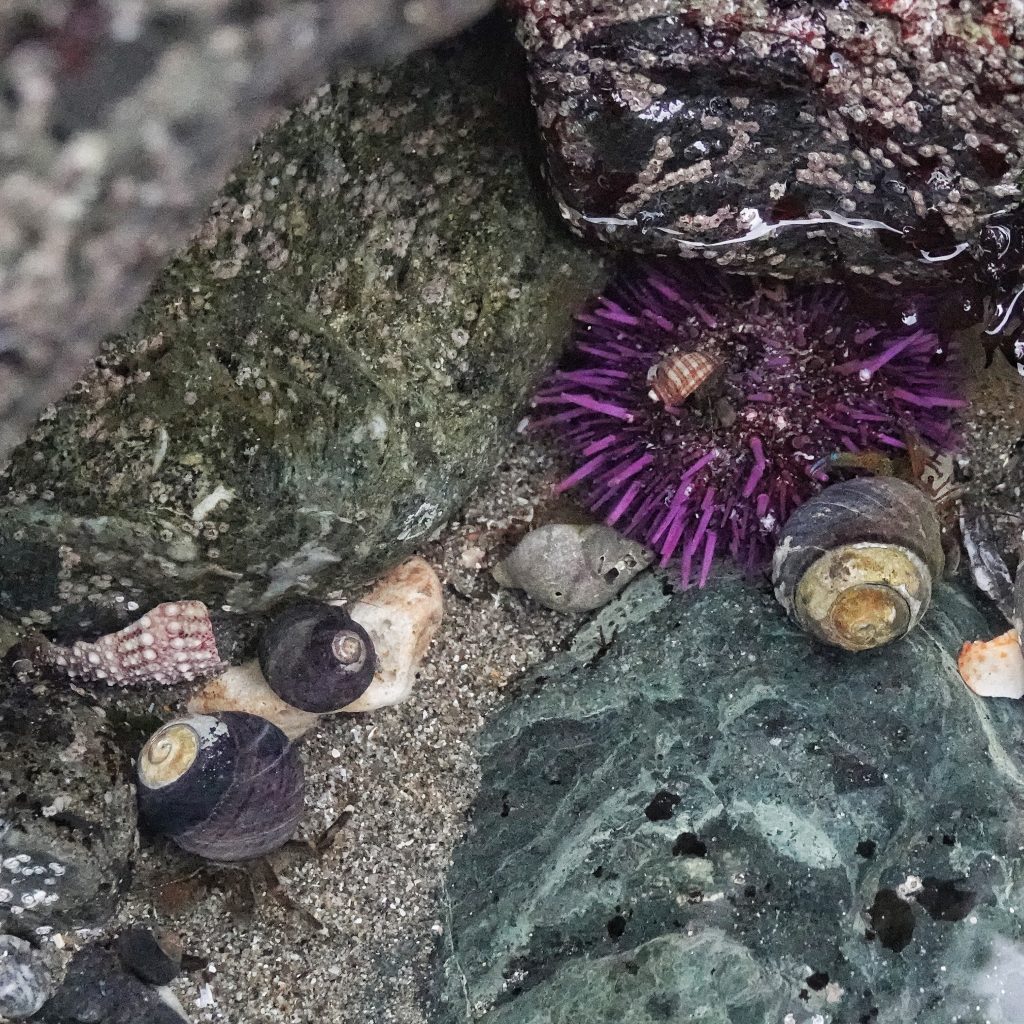
The Japanese delicacy uni sushi comes from sea urchins, and one solution to this problem might seem to be to harvest the purple sea urchins in these barrens for use as food. However, uni is actually made from the gonads of the urchins (and the giant red sea urchin is the preferred species because it has larger reproductive organs), and the purple sea urchins in the barrens are often stunted and unhealthy because of a lack of food, resulting in stunted or absent gonads.
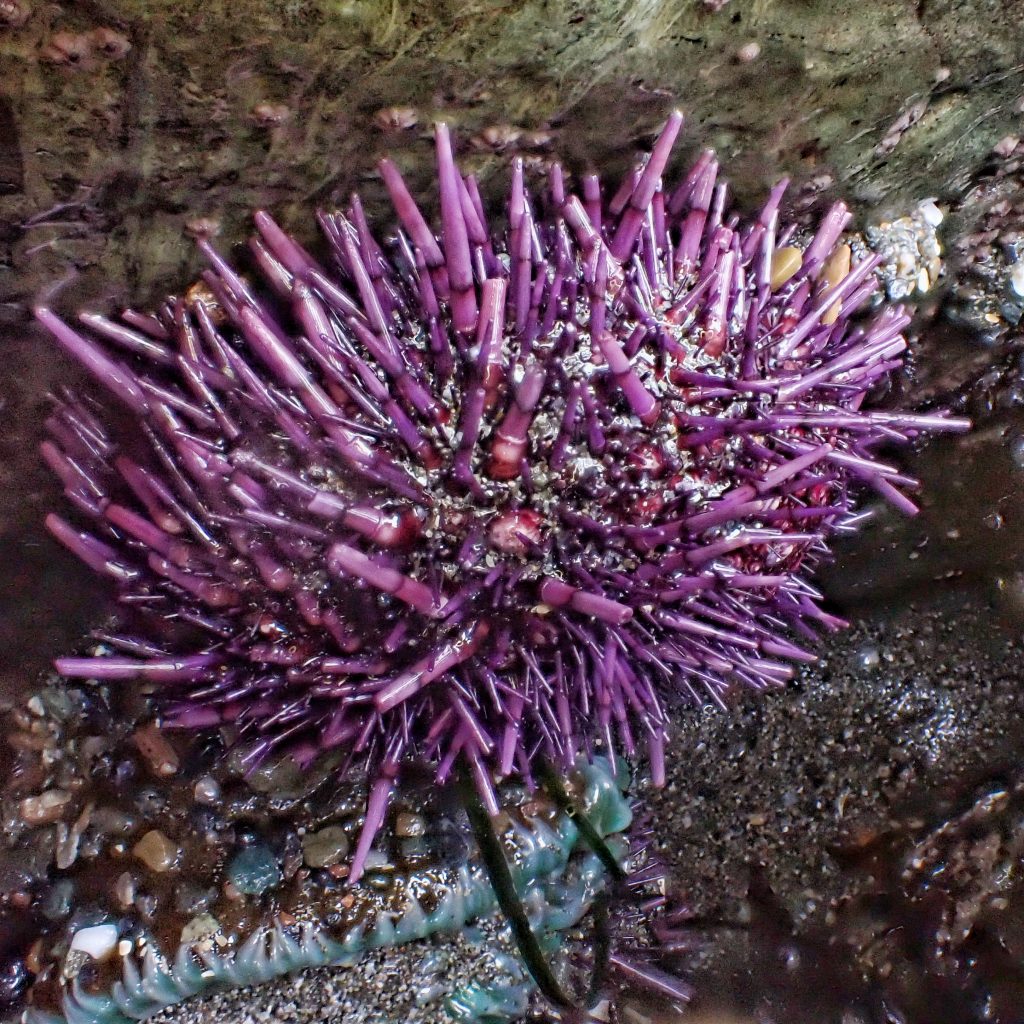
Description-Medium sized (2-4” in diameter), bright purple (juveniles may have many green spines, but always have some that are purple) sea urchin with relatively wide spines that are only 1/4-1/3 of the diameter of the test
Similar species–Mesocentrotus franciscanus (giant red sea urchin) has spines that are greater than 2/3 of the diameter of the test, and is usually much larger (up to 8” in diameter); Strongylocentrotus droebachiensis (green sea urchin) has narrow spines, is brownish green and usually has dark bands.
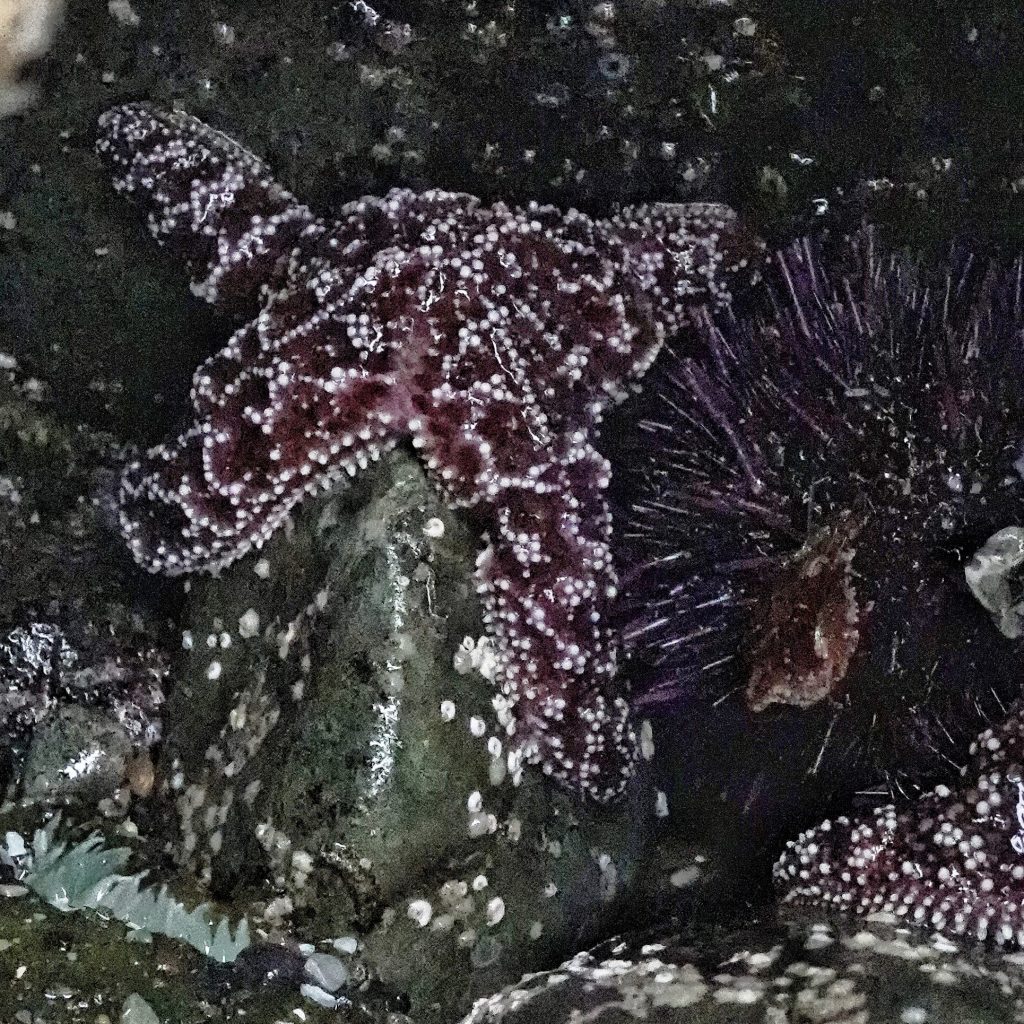
Habitat-Low intertidal zone down to 500’ below the surface, primarily on the open coast or where there is wave action to oxygenate the water.
Range-Alaska to Baja California; the entire open coast in our region, but uncommon in Puget Sound, the Salish Sea, and the inner part of the Strait of Juan de Fuca.
Adults active-Year around

Eats-Algae, primarily Macrocystis kelp when available, but will also consume other brown and red algae; has been known to eat the chiton Katharina tunica, and to scavenge dead fish, crabs, and other creatures.
Eaten by-Sea otters (who consume so many purple sea urchins that the pigment in the spines turns their bones purple); gulls and other sea birds; the sea stars Pycnopodia helianthoides (which may swallow them whole), Dermasterias imbricata, and occasionally Pisaster ochraceus; the giant green anemone Anthopleura xanthogrammica, and some species of crabs; along the California coast the fish known as California sheephead (Semicossyphus pulcher) are a primary predator.
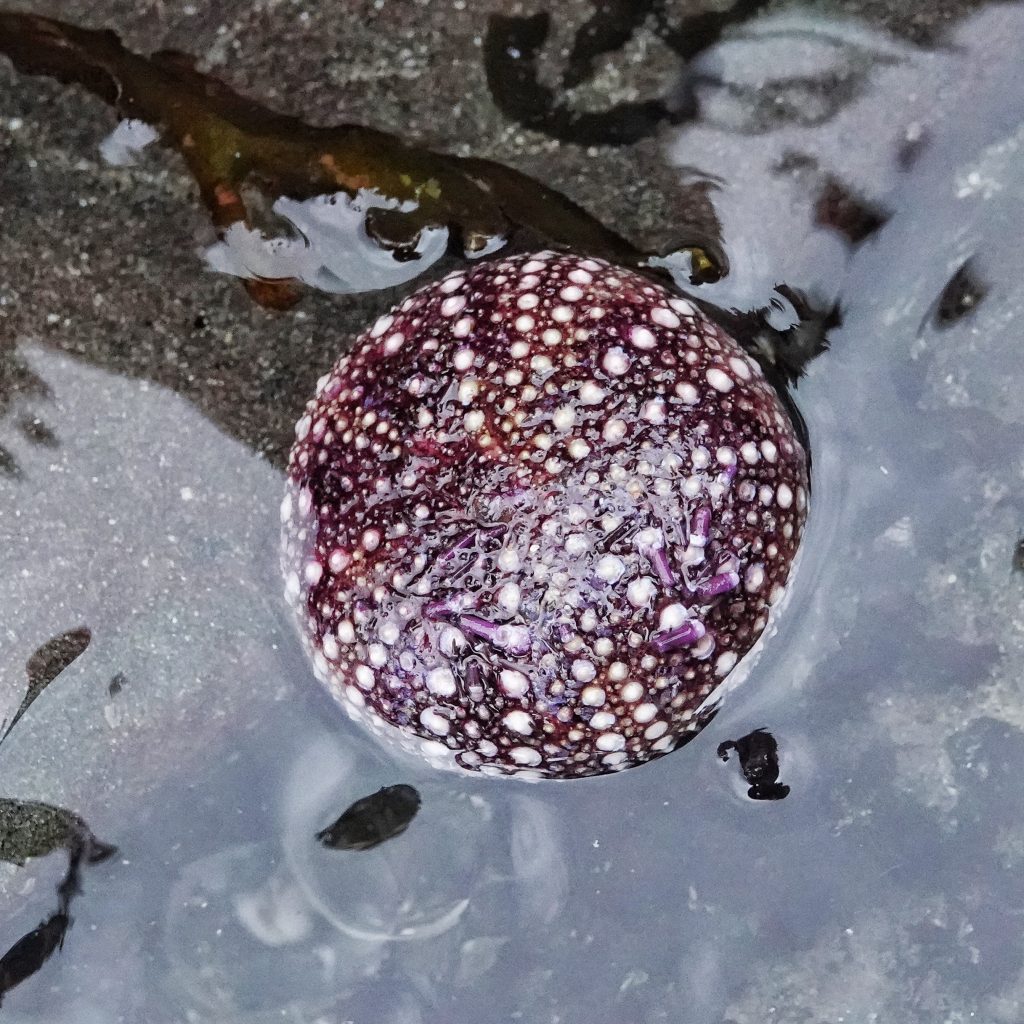
Life cycle-Broadcast spawners that release eggs or sperm from the gonapores located in the middle of the aboral surface; male release of sperm stimulates females to release eggs; occasional hermaphrodites are found in this species, but I cannot ascertain how they function for breeding; most spawning happens from January through March, but may reproduce in other time frames; in about a day the fertilized eggs hatch into ciliated, free swimming, non-feeding larvae called a blastula, which soon form a mouth and anus and become feeding larvae called gastrula; within a week or so it forms two arms to direct food to the mouth, and is then called a pluteus; after about a month in which it grows its test within the larval sac, essentially transforming from bilateral symmetry to radial symmetry, it descends to the sea floor, where such things as presence of conspecific adults (Cameron/Schroeter; 1980), presence of kelp, and turbulence of waves cue it to attach to the bottom, evert its larval sac, and emerge as a juvenile, which is superficially similar (except that the spines tend to be mostly green and the juvenile Strongylocentrotus purpuratus are only about 2mm in diameter) to an adult; reach sexual maturity at 2-5 years and 25mm diameter; may live 70 years or more, but seldom lives more than 20 years.
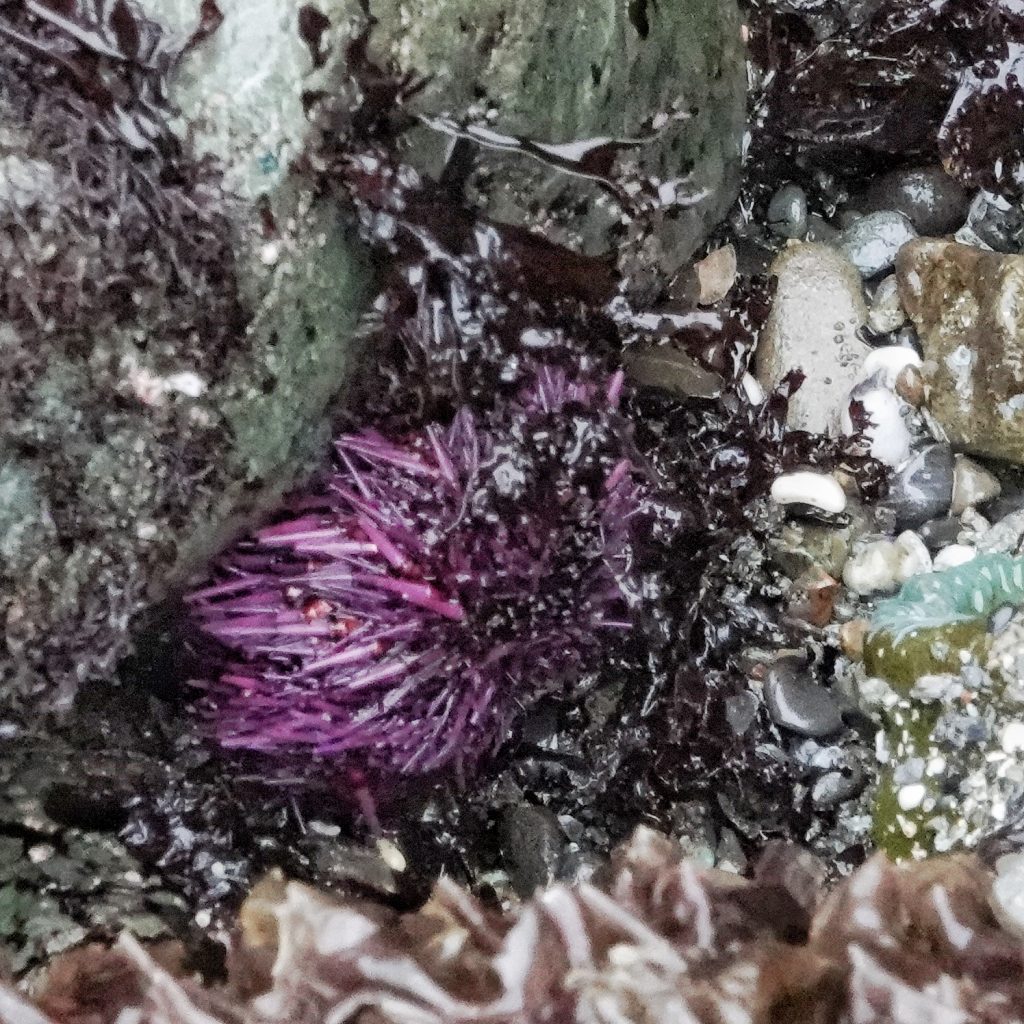
Etymology of names–Strongylocentrotus is from the Greek words for ‘ball of spines’, about as obvious a reference as one will find in a scientific name. The specific epithet purpuratus is the Latin word for ‘clad in purple’, another highly appropriate reference. The common name ‘sea urchin’ is from the Middle English word ‘yrchoun’, for hedgehogs, a spiny European mammal in the same order as moles and shrews.

https://www.montereybayaquarium.org/animals/animals-a-to-z/purple-sea-urchin
Pacific Purple Sea Urchin – Oceana
Purple sea urchin • Strongylocentrotus purpuratus – Biodiversity of the Central Coast
Microscopic marvel: A very close look at sea urchins
https://www.science.org/doi/10.1126/science.1131888
Resilience and the purple sea urchin – Washington State Department of Ecology
https://animaldiversity.org/accounts/Strongylocentrotus_purpuratus/
https://www.eopugetsound.org/species/strongylocentrotus-purpuratus
https://genomics.senescence.info/species/entry.php?species=Strongylocentrotus_purpuratus
https://www.littleurchin.com.au/blogs/news/6-facts-you-didnt-know-about-sea-urchins
Reproduction Process of the Uniquely Attractive Sea Urchins – Biology Wise
Sea Urchin Anatomy | Ask A Biologist
https://en.wikipedia.org/wiki/Pedicellaria
https://en.wikipedia.org/wiki/Madreporite
https://en.wikipedia.org/wiki/Water_vascular_system
https://aquarium.ucsd.edu/blog/the-amazing-aristotles-lantern/
https://www.int-res.com/articles/meps/2/m002p243.pdf
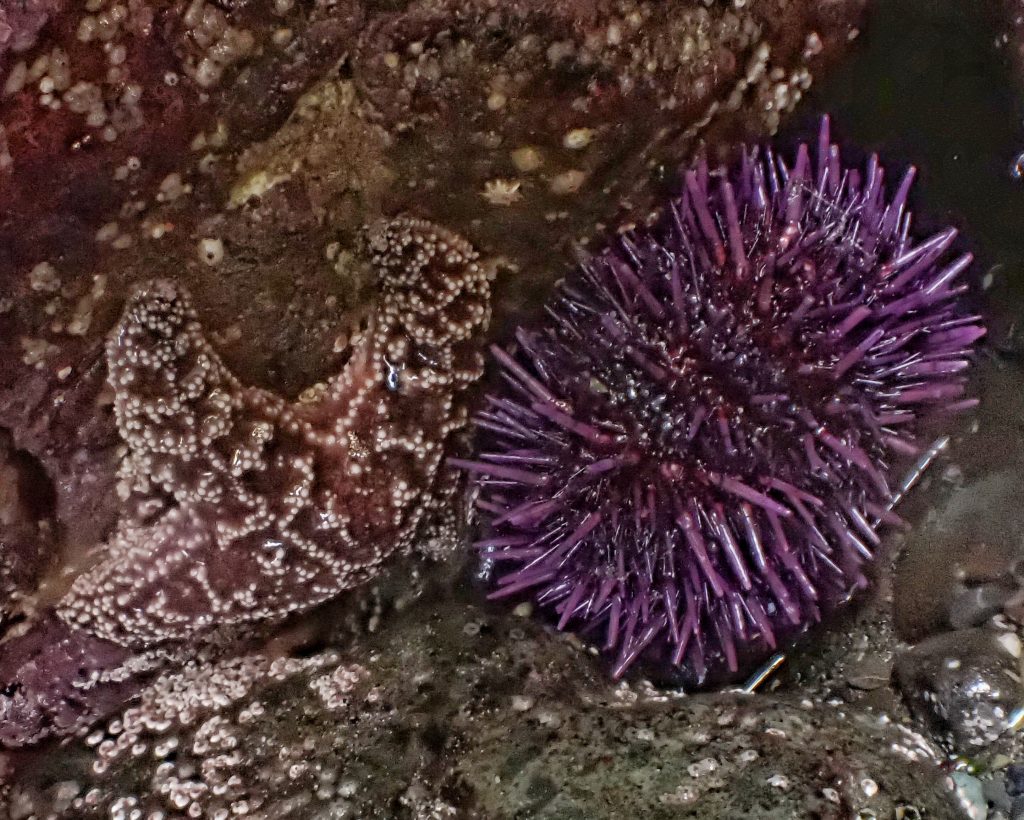
Whoa–I had no idea they could live that long, at least under ideal circumstances.
Pretty amazing creatures all the way around!
A Makah friend and I ate a few of these and they were very tasty alongside our other beach-foraged finds. I’d like to think that maybe now I still have the teensiest bit of purple in my bones, somewhere.
I hope so, Kat!